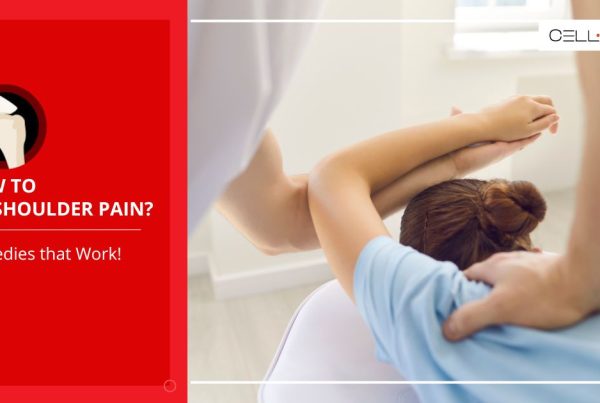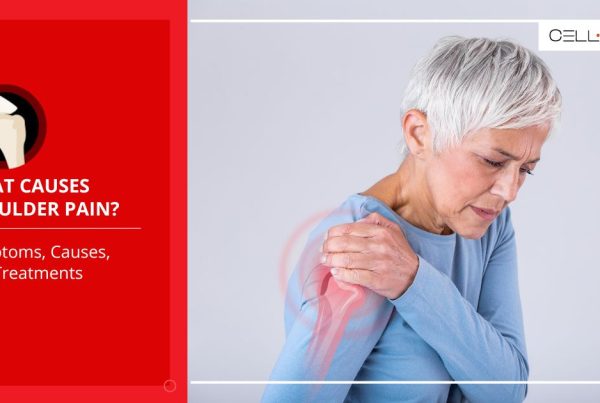Published on: April 27, 2020 | Updated on: August 29, 2024
Often when people experience pain in a certain body part they attribute that body part to the problem. This is a natural assumption and in most cases is correct. However, when it comes to arm and shoulder pain, the problem is not always what it seems.
The majority of arm and shoulder pain is caused by an injury or ailment in the arm or shoulder. Shoulder discomfort, on the other hand, might be caused by a neck issue. When shoulder discomfort is caused by a problem with one or more nerves that go from the neck to the shoulder, it is important to seek medical attention.
Is the Pain in My Arm Caused by My Neck?
C1-C8 are the eight nerve roots that branch out from either side of the cervical spine in the neck. C3 through C8 nerve roots all travel via a particular area of the shoulder.
When a cervical nerve root in the neck is compressed or inflamed, pain and symptoms can spread down the nerve’s route into the shoulder, arm, and/or hand. Cervical radiculopathy is the medical term for this condition.
Do you have throbbing pain in your arm?
Fill out the form below to schedule your FREE virtual consultation
Symptoms of Cervical Radiculopathy
Symptoms stemming from radicular pain can vary from patient to patient. They may include the following:
- Pain that ranges from mild to severe and dull to sharp.
- Pain that is intermittent or continuous.
- Pain that is localized to one region, such as the shoulder blade, or pain that extends down the arm and into the hands and fingers along the nerve.
- Tingling that feels like pins and needles and can be localized or spread across the shoulder and arm, ending in the hands and fingers.
- Numbness or weakness in the shoulder, arm, hand, and/or fingers may occur on a regular or irregular basis.
Some research indicates that shoulder pain symptoms tend to develop with the following pattern:
- C5 radiculopathy: pain in the upper arms and shoulder blades is common, although numbness or tingling is uncommon.
- C6 radiculopathy: includes numbness, tingling, and/or discomfort in the second digit (index finger) that may spread into the arm. Weakness at the front of the upper arm (biceps) or the wrist is possible.
- C7 radiculopathy: is the most frequent type, with discomfort or weakness extending from the neck to the hand, including the triceps and middle finger, which is the most prevalent.
- C8 radiculopathy: includes numbness, tingling, and/or pain from the neck down the arm and into the little finger. Handgrip weakness is a problem for patients.
What Causes Cervical Radiculopathy?
Cervical radiculopathy is frequently caused by “wear and tear” changes in the spine, such as arthritis, as we age. A sudden injury that results in a herniated disc is the most common cause in younger people.
The discs in the spine lose height and begin to protrude as they age. They also begin to lose water content, dry up and stiffen. This condition causes the disc spaces to settle or collapse, resulting in a loss of disc space height.
The vertebrae migrate closer together as the discs lose height. To reinforce the disc, the body responds by producing extra bone (bone spurs) surrounding it. The spine stiffens as a result of these bone spurs.
They can also compress the nerve root by narrowing the foramen (the tiny apertures on each side of the spinal column where the nerve roots escape). Arthritis or spondylosis are terms for degenerative changes in the discs. These changes are common and affect everyone.
Other causes of cervical radiculopathy include:
- Cervical Osteoarthritis: these arthritic changes compress the nerve roots or nerves inside the spinal cord and can induce cervical radiculopathy.
- Cervical Foraminal Stenosis: CFS (cervical foraminal stenosis) is a prevalent cause of cervical radiculopathy. The nerve root may get impinged if a foramen (bony orifice where a nerve root leaves the spinal canal) narrows. Bone spurs, thickening ligaments, or a bulging disc that presses on the nerve root in the foramen can all be signs of degenerative processes.
Treatments

Treatments for cervical radiculopathy typically include one or more of the following:
- Limit activity and rest-up: Limiting intense activities, such as sports or moving heavy things, or sitting or driving with improved posture may bring some relief.
- Heat/Ice therapy: For some patients, using an ice pack or a warm gel pack on the neck may provide pain relief. Applying cold treatment following an activity-related pain flare-up, for example, may help decrease inflammation and, as a result, discomfort. When using ice or heat therapy, it’s vital to use a covering that protects the skin from direct contact and to keep treatments to 15 or 20 minutes at a time, with a 2-hour interval in between.
- Physical therapy: A physical therapist or another qualified health practitioner may suggest a stretching and exercising plan tailored to the patient’s needs. Improving the strength and flexibility of the neck and back may help them maintain a healthier posture and become more pain resistant.
- Manual manipulation: The cervical spine can be physically adjusted by a chiropractor or other competent health practitioner to improve mobility and pain alleviation. Manual manipulation is sometimes used as part of a physical treatment program.
- Medications: Nonsteroidal anti-inflammatory medicines (NSAIDs) are the most common treatments used for inflammation caused by cervical radiculopathy. Aspirin, ibuprofen, and naproxen are among examples. If symptoms do not improve or are poorly managed, harsher drugs, such as opioid-based pharmaceuticals, prescription-strength NSAIDs, or muscle relaxants, may be provided on a short-term basis.
- Cervical traction: A device that exerts a gentle force on the neck, pulling it up slightly. The goal of this procedure is to enlarge the space between the cervical vertebrae, particularly in the intervertebral foramina, which is where the nerve roots flow. A home cervical traction device may be advised if a patient achieves symptom reduction when using traction in a clinical environment.
Treating Arm Pain with Regenerative Therapy
Alternative therapies must be considered if normal treatments are not giving pain relief from cervical radiculopathy, or if neurological symptoms of arm numbness and discomfort continue to worsen.
Stem cell therapy is one of the effective and nonsurgical solutions for cervical radiculopathy. Stem cell therapy can reduce inflammation and decrease nerve compression. The therapy can reduce pain as well as the possibility of surgical interventions.
Advancements in stem cell treatment have made it possible for doctors to treat diseases like cervical radiculopathy. After collecting and preparing the stem cells, specialists apply them directly to the damaged area.
Sources
Footnotes
- Hoffman HL. Pain in the Arm: A Review. Annals of the Rheumatic Diseases. 1948;7(1):9.
- Warren SE. The painful arm: Evaluation and treatment of vascular causes. Angiology. 1972;23(7):392-400.
- Bucy PC, Oberhill HR. Pain in the shoulder and arm from neurological involvement. Journal of the American Medical Association. 1959;169(8):798-803.
- Ko S, Choi W, Lee J. The prevalence of cervical foraminal stenosis on computed tomography of a selected community-based Korean population. Clinics in Orthopedic Surgery. 2018;10(4):433-8.
- Ireland DC. Psychological and physical aspects of occupational arm pain. Journal of Hand Surgery. 1988;13(1):5-10.
References
- Arm pain. Mayo Clinic. Accessed 2/22/2024.
- Cervical Spinal Nerves. SPINE-Health. Accessed 2/22/2024.
- What Is Cervical Radiculopathy? SPINE-Health. Accessed 2/22/2024.
- Cervical spondylosis. Mayo Clinic. Accessed 2/22/2024.
- Muscle Relaxants: List of Common Muscle Relaxers. SPINE-Health. Accessed 2/22/2024.
CELLAXYS does not offer Stem Cell Therapy as a cure for any medical condition. No statements or treatments presented by Cellaxys have been evaluated or approved by the Food and Drug Administration (FDA). This site contains no medical advice. All statements and opinions are provided for educational and informational purposes only.
Dr Pouya Mohajer
Author
Pouya Mohajer, M.D. is the Director of Spine and Interventional Medicine for CELLAXYS: Age, Regenerative, and Interventional Medicine Centers. He has over 20 years of experience in pain management, perioperative medicine, and anesthesiology. Dr. Mohajer founded and is the Medical Director of Southern Nevada Pain Specialists and PRIMMED Clinics. He has dedicated his career to surgical innovation and scientific advancement. More about the doctor on this page.
Dr Pejman Bady
Contributor
Dr. Pejman Bady began his career over 20 years ago in Family/Emergency Medicine, working in fast-paced emergency departments in Nevada and Kansas. He has served the people of Las Vegas as a physician for over two decades. Throughout this time, he has been met with much acclaim and is now the head of Emergency Medical Services in Nye County, Nevada. More about the doctor on this page.









